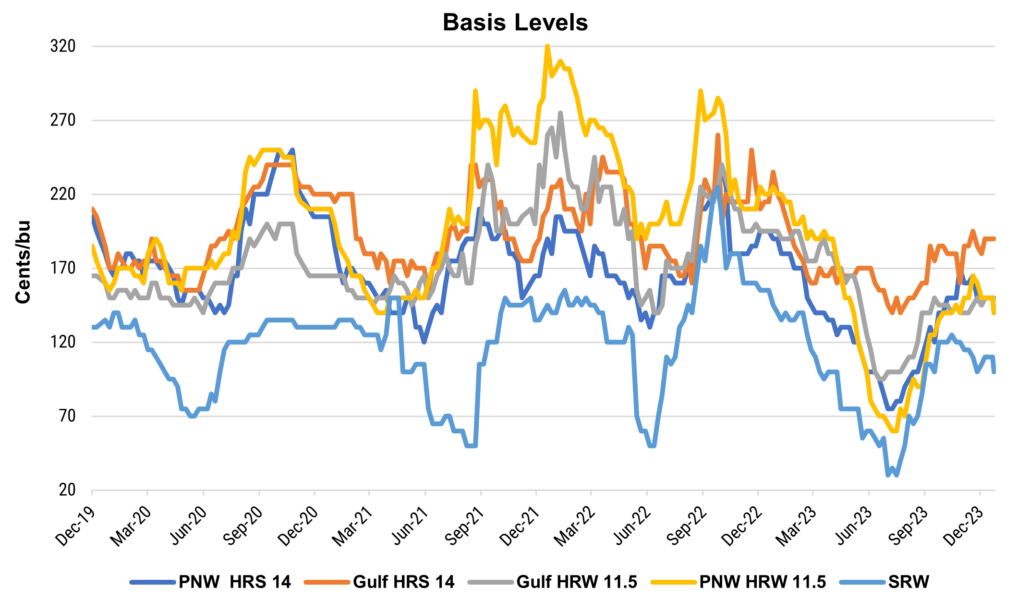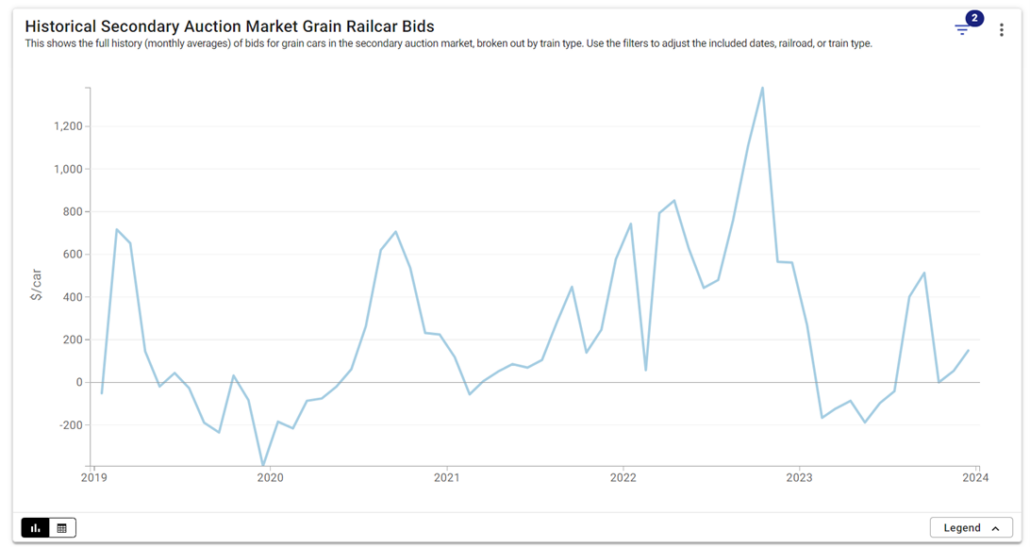U.S. Wheat Export Basis Levels Support On-Going Competitiveness

During the summer of 2023, U.S. wheat export basis levels hovered near record lows as slow demand met seasonal weakness. Across almost all the U.S. wheat classes and export points, export basis levels hovered below average, signaling a unique pricing opportunity for U.S. wheat. Historical trends indicate that basis levels generally hit their lowest point during wheat harvest and increase in October, November, and December as export capacity tightens in response to an influx of corn and soybeans.
Following the seasonal pattern, U.S. export basis levels have since risen for all U.S. wheat classes. Despite the increase, the average HRS basis for the Gulf and Pacific Northwest sits 15% below the five-year average, while HRW and SRW sit 31% and 27% below the five-year average, respectively. The following examines the underlying factors driving this trend and its impact as we dive into the second half of marketing year 2023/24.

U.S. export basis levels generally follow a seasonal pattern, hitting lows during the wheat harvest and highs during October, November, and December as elevation capacity tightens in response to the corn and soybean harvest. In July 2023, basis levels hovered near record lows as seasonal weakness was coupled with an overall lack of demand. Source: U.S. Wheat Associates Price Report.
Excess Capacity Meets Slow Demand
The most significant factor influencing the below-average basis values is the overall decrease in export volume for grains and oilseeds, particularly for soybeans. According to USDA, for the week ending December 28, 2023, inspections for all grains (wheat, corn, and soybeans) were down 19% from the same period last year and 39% below the three-year average.
U.S. soybean exports are down due primarily to South American competition in the Chinese market. Reflected in the December 2023 World Agricultural Supply and Demand Estimates, forecast for U.S. soybean exports to all destinations came in at 47.6 MMT, down from 54.2 MMT in 2022/23 and 58.6 MMT in 2021/22. Meanwhile, total Brazilian exports are forecast at a record 99.5 MMT, up from 95.5 MMT the year prior and 18% above the five-year average as record quantities of soybeans are exported to China.
U.S. wheat exports face similar competitive headwinds. USDA export data shows that the export pace sits 14% behind last year and 26% below the five-year average.

Secondary Railcar Auction Market Bids (a real-time reflection of the supply and demand for rail freight) for October, November, and December sit at $65.12/car on average, down from $836.11/car last year and the five-year average of $262.96/car. The combined impact of excess capacity within the grain handling and logistics system has removed pressure on wheat basis levels and allowed them to drift lower. Source: USDA Rail Transportation Dashboard.
The decrease in overall grain volume has created surplus capacity in the U.S. logistics systems, particularly for the railroads. As a result, Secondary Railcar Auction Market Bids (a real-time reflection of the supply and demand for rail freight) for October, November, and December sit at $65.12/car on average, down from $836.11/car last year, and the five-year average of $262.96/car. The combined impact of excess capacity within the grain handling and logistics system has removed pressure on wheat basis levels and allowed them to drift lower.
Basis Levels Support Competitiveness
As overall grain export volume remains below average, we can expect the depressing impact on the basis to continue. South American competition for soybean exports will continue to influence grain markets, forcing participants to readjust to the changing dynamic.
The combined impact of below-average basis levels and the downward trend in wheat futures prices, driven by competition from the Black Sea, Canada, and other origins, has helped improve U.S. wheat competitiveness throughout 2023/24. Therefore, basis movements will continue to play a key role in maximizing value and capitalizing on opportunities as they arise in the market.
By USW Market Analyst Tyllor Ledford.
Read also
Write to us
Our manager will contact you soon



